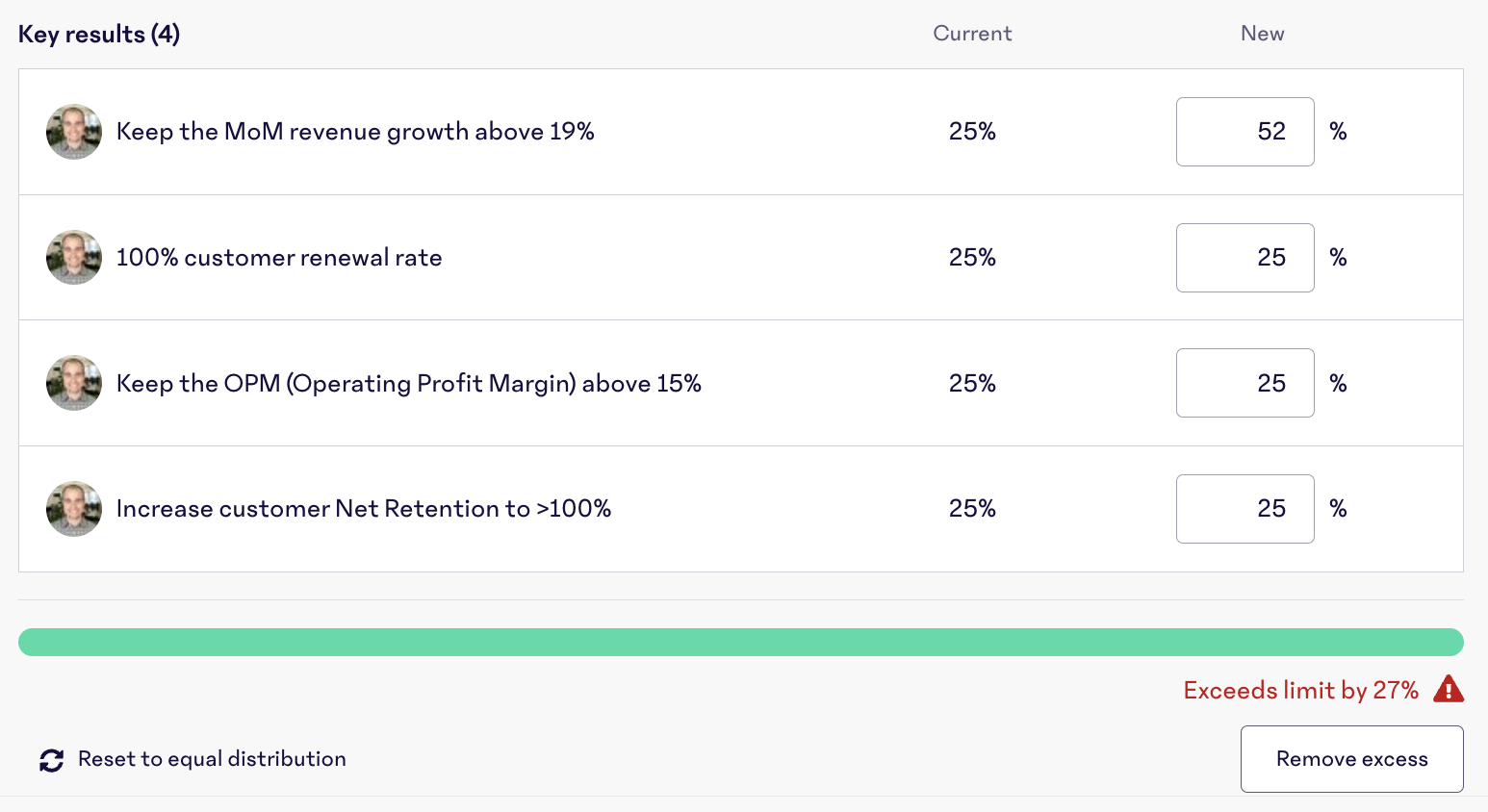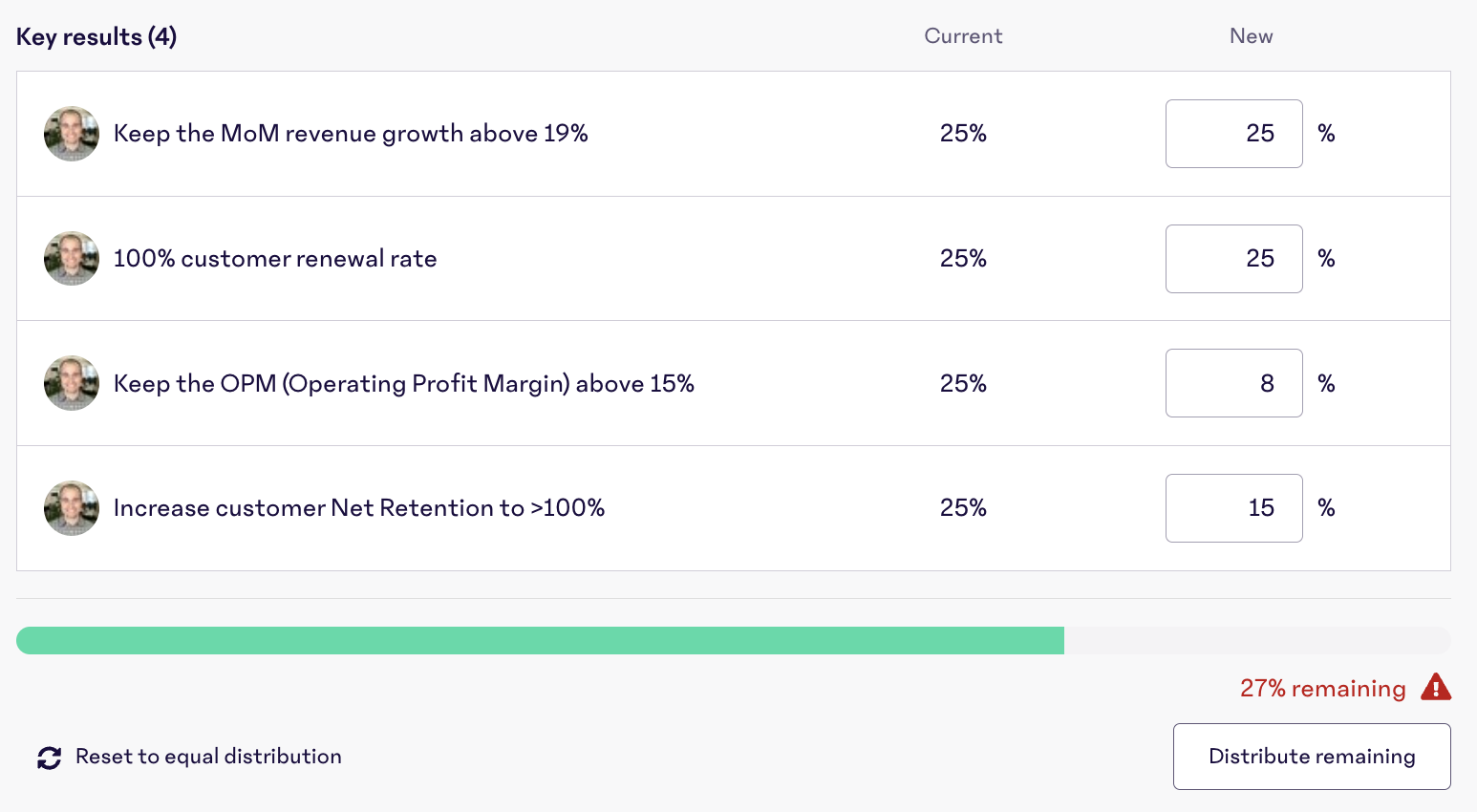Historically, and by default, all Key Results or aligned child Objectives that impact the parent objective's progress are weighted equally. However, equal weighting is not always accurate to the degree of impact a specific Key Result or child Objective may have on the whole. Applying custom weights can help to ensure that the most critical outcomes have the greatest impact on overall progress.
In this article, you will learn...
- How to assign weight to a Key Result or child Objective
- How to balance the Key Result weights
- FAQ's and Troubleshooting
Access and availability
⛔️ Required access to Objectives.
👥 This article is relevant to all roles.
📦 This feature is available in the Perform, Legacy Focus, and Total Platform pricing packages.
Note
If you are an account administrator, you can set permissions for the Objectives feature here, including who can create company-wide objectives, who can create/edit/manage objectives, and much more.
Assign weight to a Key Result or child Objective
- Open the Manager tools dropdown in 15Five's main, left-hand navigation, then click on Objectives
- You will land on the 'All objectives' page. From here, click Create a new objective and follow the process here to configure your objective.
- As you add Key Results, weights are assigned evenly by default across all Key Results in the objective. You’ll see the weight shown on each Key Result row. With 3 Key Results added, each Key Result is 33.3%.
Add a 4th Key Result and all four redistribute automatically to 25% each. This default behavior keeps the total at 100% until you choose to manually edit weights. - If equal weighting is fine, continue creating the objective. If you want certain Key Results to count more (or less), you can click the Weight: __% badge on any Key Result or select "Edit key results weights" link at the bottom of your Key Results list.
This opens the Edit weights pop‑up - In the pop‑up, type the desired % for each Key Result. As you edit, the running total updates. The Save button becomes enabled only when the total equals 100%.
- Click Save to apply the distribution to the Objective.
- Navigate to the Objective you would like to adjust the Key Result or Child Objective weights for
-
In the Objective, either click the Weight: __% badge on any Key Result or select "Edit key results weights" link at the bottom of your Key Results list.
This opens the Edit weights pop‑up:
- In the pop‑up, type the desired % for each Key Result. As you edit, the running total updates. The Save button becomes enabled only when the total equals 100%.
- Click Save to apply the new distribution to the Objective.
Balancing the Numbers
If your total weights add up to more than 100%, you’ll see an inline message in the Edit weights window that reads “Exceeds limit by __%”:

The Save button will remain disabled until the total equals 100%. The system will not automatically rebalance the other Key Results for you. Instead, you can choose one of the following options:
If your total weights add up to less than 100%, you’ll see an inline message that says “__% remaining":

The Save button will remain disabled until the total equals 100%. The system will not automatically allocate the remaining percentages to other Key Results for you. Instead, you can choose one of the following options:
FAQ's and Troubleshooting
-
Q: How is progress calculated for an Objective?
A: Progress is determined by the weighted completion of each Key Result and any weighted child Objectives. Higher-weighted items move progress more than lower-weighted or unweighted ones. -
Q: How do child Objectives affect progress?
A: If a child Objective should contribute to a parent Objective’s progress, assign it a weight within the parent Objective so its completion influences the parent’s overall progress. -
Q: Can weights be added or changed after an Objective or Key Result is already created?
A: Yes. You can edit weights anytime by selecting the settings gear → Edit weights, or by opening the Key Results section within the Objective. -
Q: Who can set or edit weights?
A: Anyone with permission to create or edit Objectives can add or adjust weights. -
Q: What do I do if I have a child Objective that should impact its parent?
A: Make sure the child Objective has a designated weight alongside the parent’s Key Results. If it’s not weighted, its progress won’t roll up into the parent’s total. -
Q: What happens when I add another Key Result?
A: When a new Key Result is added, weights are automatically evenly distributed across all Key Results by default. You can then edit them manually. -
Q: Can a Key Result have 0% weight?
A: Yes. You can set a Key Result to 0% if it shouldn’t influence overall progress. Additionally, a child objective can have a 0% if it should not impact the parent objective’s overall progress. -
Q: Where is the setting to remove a child objective from impacting parent objective progress?
A: While the radio button setting after aligning a child objective to a parent has been removed, impact of the child to the parent’s progress can now be determined with the assigned weight to the child objective within the parent objective’s settings. See the question "Can a Key Result have 0% weight?" above. -
Q: Why is the Save button grayed out?
A: Weights must total 100% for Save to activate in the "Edit weights" modal. If totals are over or under 100%, adjust the weights or use the Remove excess / Distribute remaining buttons to proportionally adjust the weights before saving. -
Q: There is an “Exceeds limit by __%" error. What do I do?
A: Click the Remove excess button to subtract the overage evenly across all Key Results, use the –__% action to remove the full excess from one eligible Key Result, or manually adjust the Key Results to total 100. The system will not automatically rebalance weights. -
Q: There is a “__% remaining" error. What do I do?
A: Click the Distribute remaining button to add the remaining evenly across all Key Results, use the +__% action to add the full remaining value to one eligible Key Result, or manually adjust the Key Results to total 100. The system will not automatically rebalance weights. -
Q: What if I close the Edit weights window before saving?
A: Any unsaved changes are discarded — previous weights remain unchanged. -
Q: What’s the quickest way to reset weights?
A: Select Reset to equal distribution in the "Edit weights" window to start over with evenly distributed weights. -
Q: Is weighting integrated with the Performance Ratings formula?
A: Not at this time.